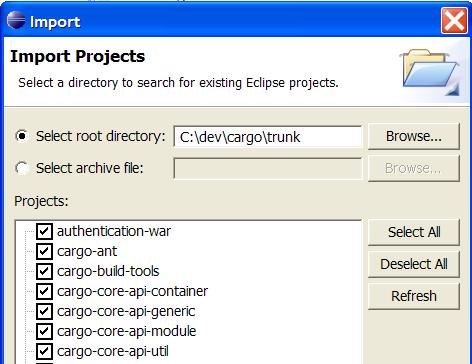This tutorial explains how to import Cargo sources from Subversion into your IDE (Eclipse and IntelliJ IDEA are covered).
- Start by checking out the Cargo sources from Subversion. You can do that using the Subversion command line, TortoiseSVN (recommended for Windows users), your IDE Subversion feature (for Eclipse you'll need the Subclipse plugin) or any subversion client tool.
- Install the latest version Maven2. Make sure it's installed properly by typing
mvn --version.
- Open a shell in the top level directory where you have checked out the Cargo sources (this directory should have a
build-toolssubdirectory in it and it should contain apom.xmlfile).
For Eclipse users
- Type "mvn eclipse:eclipse". This generates Eclipse files automatically.
- Start Eclipse.
- Go to Windows|Preferences|Java|Build Path|Classpath Variables and add a M2_REPO variable to point to your local Maven2 repository (usually in
~user/.m2/repository). See also the documentation on the Maven Eclipse plugin. - Select "Import|Existing Project into Workspace". Point it to the top level directory of the checked-out Cargo sources. You should see something similar to the following figure:
Note: Maven supports a nested directory structure whereas Eclipse currently only supports a flat structure. The Maven2 Eclipse plugin creates an Eclipse project per Maven module (i.e. per directory containing a pom.xml file). This means that directories with no pom.xml will not be listed. This is a known issue with Eclipse and Maven. In the future the hope is that Eclipse will support nested project structure.
For IntelliJ IDEA users
- Type "mvn idea:idea". This generates IDEA project files automatically.
- Start IntelliJ IDEA.
- Select "File|Open Project..." and select the Maven-generated project as shown in the following figure:

